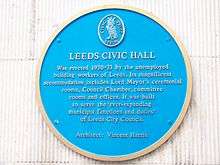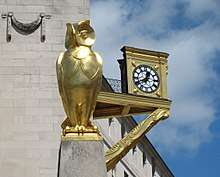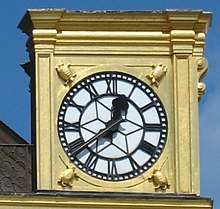Leeds Civic Hall


Leeds Civic Hall is a civic building located in Millennium Square, Leeds, West Yorkshire, England. The building houses Leeds City Council and includes offices such as the Lord Mayor's room, council chambers and a banqueting hall, and is a Grade II* listed building.[1] It replaced Leeds Town Hall as the administrative centre in 1933.[2]
History
The design was the result of a competition held in 1926, which was won by Vincent Harris. Work began in 1931 and the hall was opened by King George V on 23 August 1933.[3][4] Costing £360,000 to construct, this was covered by a government grant to create work for the unemployed.[2][3][4]
Architecture
_002.jpg)
Exterior
It is on a triangular site at the top of a slope, looking down over what is now Millennium Square. It has a symmetrical front, but is in the form of a truncated V[1] where the west wing is longer than the east one.[5] It is made of Portland stone with a roof of green slate in Palladian style.[1][5] The main portico covers two storeys with a pediment supported on six large Corinthian columns.[3][5] The two wings have five storeys.[1] There are two large towers on the front face, in the style of Christopher Wren[1][2][5] and 170 feet (52 m) tall.[3][4] These are said to be modelled on the spire of the church of St Vedast by Nicholas Hawksmoor as they were not in the original design.[5] The public entrance is through the main south face, with staff entrances on each of the two wings. The two wings partially enclose a courtyard at the north side, with the Councillors' entrance.[5]
Decorations


There is a golden owl on top of each tower by John Hodge, who also carved the coat of arms in the pediment.[5] Each is cast in bronze, covered in gold leaf, is 2.3 metres (7 ft 7 in) tall and weighs half a ton.[3][6] The owl comes from the city seal, itself from the coat of arms of the first Alderman, Sir John Savile.[2] A further 4 owls by City Architect John Thorp were erected on square columns in 2000 as part of the creation of Millennium Square.[7] There is also a gilded clock on a bracket on the each wing.[1] This has tortoises around the dial,[3]
Interior
There are marble floors throughout. The 90 feet (27 m) entrance hall is lined with grey gritstone and green scagliola columns.[5][3] The main staircase has stained glass windows by George Kruger Gray[5] and at the top a bust of King George V by William Reid Dick.[3] This leads to a 90 feet (27 m) long reception hall with three domed saucer ceilings, also by Gray.[5] The Assembly Hall was 100 feet (30 m) long and oak panelled is across the front of the building, now divided to a banqueting hall and other chambers. There is a parlour for the Lord Mayor at the East end and one for the Lady Mayoress at the West end.[5] The Council Chamber is a deep room below entrance level, with an oval seating arrangement. It is lined with walnut wood and hollow acoustic panels of artificial stone.[5]
 Stained glass and green columns
Stained glass and green columns First floor ceilngs
First floor ceilngs Ceiling detail
Ceiling detail Banqueting Chamber
Banqueting Chamber Council Chamber
Council Chamber Lady Mayoress' Room
Lady Mayoress' Room The Blue Room
The Blue Room
See also
References
- 1 2 3 4 5 6 "Civic Hall". historicengland.org.uk. Retrieved 21 June 2018.
- 1 2 3 4 Mitchell, W. R. (2000). A History of Leeds. Chichester: Phillimore. p. 4, 136, 153. ISBN 1 86077 130 0.
- 1 2 3 4 5 6 7 8 Mee, Arthur (1941). Yorkshire West Riding. Hodder & Stoughton. p. 233-234.
- 1 2 3 "Leeds nostalgia: Royal occasion for Leeds Civic Hall". Yorkshire Evening Post. 25 August 2013. Retrieved 22 June 2018.
- 1 2 3 4 5 6 7 8 9 10 11 12 Wrathmell, Susan (2005). Pevsner Architectural Guides: Leeds. Yale University Press. p. 80-82. ISBN 0-300-10736-6.
- ↑ "Five things: Leeds Civic Hall". Yorkshire Evening Post. 11 October 2016. Retrieved 22 June 2018.
- ↑ "Golden Owl". www.talkingstatuesleeds.co.uk. Retrieved 22 June 2018.
External links
| Wikimedia Commons has media related to Leeds Civic Hall. |